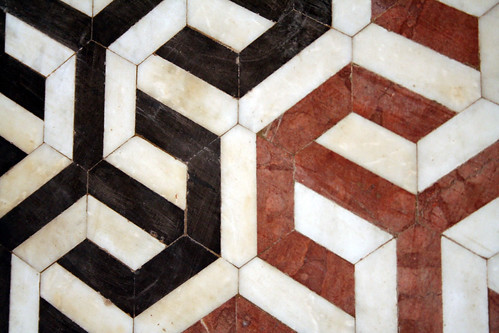 Those wondrously intricate tile mosaics that adorn medieval Islamic architecture may cloak a mastery of geometry not matched in the West for hundreds of years.
Those wondrously intricate tile mosaics that adorn medieval Islamic architecture may cloak a mastery of geometry not matched in the West for hundreds of years.Historians have long assumed that sheer hard work with the equivalent of a ruler and compass allowed medieval craftsmen to create the ornate star-and-polygon tile patterns that cover mosques, shrines and other buildings that stretch from Turkey through Iran and on to India.
Now a Harvard University researcher argues that more than 500 years ago, math whizzes met up with the artists and began creating far more complex tile patterns that culminated in what mathematicians today call "quasi-crystalline designs."
Quasi-crystal patterns weren't demonstrated in the West until the 1970s.
"It shows us a culture that we often don't credit enough was far more advanced than we ever thought," contends Harvard graduate student Peter J. Lu, who studied the question after a vacation in Uzbekistan left him marvelling at the tilework.
This isn't run-of-the-mill geometry. Quasi-crystals are made by fitting together a set of shapes, including five- and 10-sided shapes, into patterns that, unlike typical tile floors, don't repeat.
In Friday's edition of the journal Science, Lu and Princeton physicist Paul Steinhardt report finding a set of polygon-shaped tiles — a decagon, pentagon, diamond, bowtie and hexagon — that were arranged into distinctive patterns found on major Islamic buildings from the 12th through 15th centuries.
Examining architectural scrolls that were essentially training manuals for the time period, he found hand-drawn outlines of the five shapes. And when he combed through thousands of photos of medieval Islamic buildings, he found that same set of shapes increasingly used over the years to make ever-more complex patterns, including a seemingly true quasi-crystal by 1453.
It's not the first time such a link has been suggested.
But if it's right, "this would be a hitherto undiscovered episode in the spectacular developments of geometry in central Islamic lands ... achieved by artisans probably inspired by theoretical mathematicians," said Islamic art specialist Oleg Grabar.
From: CBC NEWS


No comments:
Post a Comment